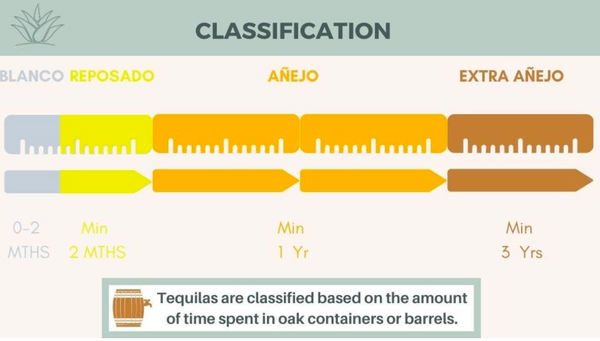
In this section, we are going to learn about the 5 classifications of tequila.
Each classification represents a certain amount of time tequila had spent in oak barrels or containers.
The five classifications are blanco, joven, reposado, añejo and extra añejo.
This is a compulsory element for all tequila, so you should be able to see this aging statement on any tequila bottle.


Blanco tequilas are the unaged tequilas.
While they can be aged for a maximum of 2 months, most producers never age them at all.
You may find alternative words on the label such as “plata” or “silver”. They all refer to the same as blanco.
Blanco means white in Spanish and it is a direct reference to the color.
The aroma of a blanco tequila is the closest to the aroma of the cooked agave of all classifications.

Our next classification is joven. Joven is more famous as “gold” or “oro” tequila.
There is no aging requirement here, the word “gold” is a reference to the color of the tequila as the first gold tequilas were basically colored versions of the white ones. It doesn’t have to do anything with quality like gold medal or silver medal for the blanco.
Gold tequilas are either blanco tequilas with caramel coloring and other additives or a mix of blanco tequila with reposado, añejo or extra añejo. Because of the lack of aging requirements, some of them are very oaky, sweet, others are just caramel colored blancos.

The next classification is reposado.
Reposado means rested. These tequilas undergo at least 2 months of aging in oak containers.
These containers can be large oak vats or even small barrels and there is absolutely no limitation for the size of the barrels.
Reposado tequilas can have many different kinds of colors from light yellow to amber and brownish. Reposado tequilas have an oaky feel to them, that if made properly can represent a good balance of the agave and the oak.

The next classification is the añejo.
Añejo tequilas undergo at least 1 year of aging in oak barrels that are restricted to a capacity of maximum 600L.
Añejo tequilas are usually darker than reposado tequilas of the same producer and its color typically gets into the darker ranges of yellow to brown.
In case of añejo tequilas, the oak may start to dominate the flavor profile and it is usually harder to find the classic agave notes.

The last classification is the extra añejo.
Extra Añejo tequilas are the oldest with an aging period of at least 3 years.
Like their añejo brothers, they also have a restriction of maximum 600L barrels.
The color of these tequilas usually range from the darkest yellow to dark brown.
After only 3 years of aging, the tequila can develop a flavor profile very similar to other aged spirits like whisky, cognac or rum.

You may have noticed that there are no upper limits for aging. It means that a 4 year old tequila can still be a reposado, right? Ever wondered why? The best way to understand how the aging system works is to look at another spirit like Scotch. Most consumers when looking at a label that says 12 years old would instantly think of a barrel that was aged for only twelve years.
Such whiskies and tequilas exist and they are called single barrel editions. However most aged spirits are a blend of barrels of different ages. When a spirit is a blend of barrels, the youngest in the blend counts. However producers are not restricted to only use 12 years old barrels, so a 12 year old whisky can have some 14, 18, 30 even a 100 years old barrel.

The same way, the tequila industry do not restrict producers to only blend “reposado” grade barrels to get a reposado.
While a 4 years old tequila may qualify as a reposado, it also qualifies as an extra añejo so producers will prefer to use extra añejo, because they can ask more money for it. And if they decide to blend the 4 years old barrel with a 6 months old barrel, then it will no longer classify as extra añejo, so the reposado term will be used instead.

So why do we see words instead of numbers on the tequila label?
As most tequilas are aged for a short time, putting on an age indication is just not very appealing. Just imagine 0.2, 1 and 3 years on the label. Who would ever pay in some cases thousands of dollars for an extra añejo with a number 3 on the label, when you could get cheaper 12 years old spirits right?
Also people tend to forget about the 5-6 years agave growing time which does not count for aging purposes. Tequila usually costs higher because of the ingredient cost, while whiskies and rums are made of cheaper ingredients but are aged longer. So do you prefer blanco tequila? No problem there, you are drinking a tequila made of approximately 6 years old agaves.
This feature is brought to you by Tequila Stop and the International Tequila Academy.
Tequila Stop aims to share is love for Mexico and its beloved Spirit with fans in Asia Pacific, bringing fans the best that Tequila has to offer, through an extensive catalogue of premium Tequilas and Mezcals straight from the source. Tequila Stop works closely with Mezcaleros across Mexico, and is also partners with the International Tequila Academy.








